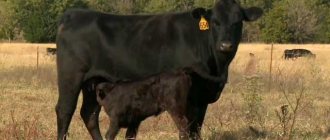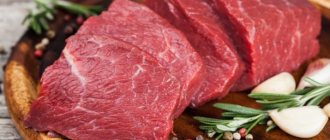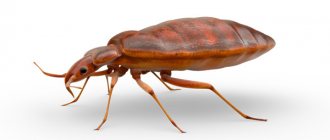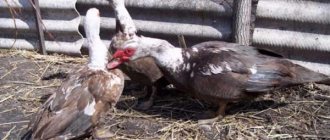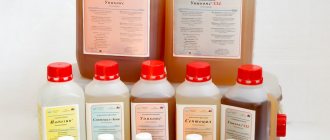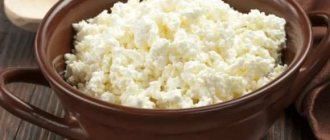You bought homemade milk and put it in the refrigerator, but after some time it does not sour, but becomes bitter. This outcome is alarming and makes you doubt the quality of the product, but do not be alarmed. Bitterness in milk does not appear out of nowhere and is not a sign of counterfeit; this phenomenon can be called normal. Our explanations will help you understand why this happens.
Why doesn't milk turn sour?
The normal microflora of milk includes beneficial microorganisms that feed on sugar. They convert it into acid, which leads to souring.
The process of lactic acid fermentation is the result of the activity of lactic and propionic acid bacteria, kefir grains, and milk yeast. The addition of certain bacteria helps produce tasty fermented milk products.
The shelf life of homemade milk is short. After about two hours of exposure to air, it begins to sour with the gradual formation of a clot with a sour cream aroma - curdled milk. By adding the appropriate starter to it, you can prepare cottage cheese, fermented baked milk, and kefir.
Boiling homemade milk increases its shelf life to several days, and storing it in the refrigerator – up to two weeks.
Milk does not turn sour if:
- the animal suffers from ketosis - a metabolic disease (disorder of carbohydrate, protein, fat metabolism), leading to the accumulation of ketone substances (acetone, acetoacetic, beta-hydroxybutyric acid) in the cow's body. The pathology may not manifest itself in any way, but the milk practically does not sour, and the cream has a distinctly bitter taste;
- the animal’s diet is disrupted: a large amount of protein food, mint, non-compliance with the proportions of sugar and protein.
- soda, antibiotics, ammonia, peroxide, preservatives, and other substances have been added to the raw materials or animal feed;
- the drink is diluted with water;
- the product has excessive fat content. Due to the thick layer of cream, oxygen does not penetrate into the liquid, which prevents fermentation;
- the product was obtained before calving;
- The drink is stored in the refrigerator, not in a warm place. This slows down the proliferation of lactic acid bacteria and souring;
- old, inactive starter was used;
- The dairy product is stored in a hermetically sealed container.
The safety of store-bought milk, unlike homemade milk, depends on the method of heat treatment of the raw materials, but in all cases it lasts longer than homemade milk. Best before date:
- sterilized - up to six months, which is due to the almost complete destruction of microflora;
- pasteurized - in the refrigerator from five days to two weeks, depending on the production method.
The production of UHT milk involves short-term exposure of raw materials to high temperatures followed by cooling. In the process, many substances useful to the body are preserved, but the microflora is destroyed and bacterial spores necessary for souring are destroyed. The finished product is bottled in sealed packaging under sterile conditions, which increases its shelf life to six months at room temperature. If automated bottling occurs and the integrity of the packaging is compromised, the shelf life is reduced to two weeks.
Some manufacturers preserve the freshness of milk by adding stabilizing additives prohibited by state standards to low-quality raw materials. The addition of phosphate products for thermal stability allows the dairy product to withstand high-temperature heating and not sour for more than five days.
Factors influencing bitterness
Liver diseases
The most common reason why a cow’s milk taste changes is serious disturbances in the animal’s liver. The functioning of this organ can be disrupted by bacteria, viruses, parasites and toxins. With a weak metabolism and impaired blood circulation, there is a high probability of contracting hepatitis.
A diseased liver immediately lets you know about malfunctions in its functioning through the cow’s bitter milk. In addition, with liver diseases, the animal develops characteristic symptoms:
- vomiting and loose stools;
- body temperature rises and breathing becomes more frequent;
- the liver area swells, and this becomes visible to the naked eye, and the animal reacts painfully to palpation of this organ;
- milk secretion decreases significantly and the quality of milk changes - it becomes more liquid and watery.
Bile
Curvature of the gallbladder and problems with the size of the bile ducts are the most common abnormalities from birth in many cattle. Deformation of these organs leads to the retention of bile in the body. This does not have the best effect on the characteristics of the milk; it acquires a yellowish tint and a bitter taste.
In the hot season, when bacteria are most prone to active reproduction, cows may develop leptospirosis (damage to capillaries, kidneys, liver and muscles due to their intoxication). This disease is usually asymptomatic and long-lasting. It rarely happens that the disease makes itself known through fever, diarrhea, jaundice or dark urine.
Asymptomatic leptospirosis always affects the characteristics of cow milk, namely, it worsens its taste.
Mastitis
If an infection is introduced (in the process of violating the rules of milking and in case of non-compliance with sanitary rules for keeping the individual), udder mastitis may develop. This disease occurs in acute and chronic forms. The acute form causes various complications in the animal, including swelling of the udder followed by gangrene. When the disease is advanced, milk is expressed with purulent clots and even blood.
Chronic mastitis makes expressed milk patchy and watery in appearance. Its fat content decreases and uncharacteristic particles of flakes and clots appear in the composition. Such milk is impossible to drink because of its sharp bitterness.
If mastitis is suspected, products should be sent for laboratory testing. If bacterial rods and cells in the process of inflammation are found in the composition, it means that it was this disease that affected the taste of the product and introduced bitterness into it.
Metabolic processes in the body, helminths
An excess of acetoacetic acid and acetone in the cow's body (in case of metabolic disorders) leads to the fact that these substances inevitably enter the body fluid, which causes the bitter taste of milk.
Increased stomach acidity and blood sugar levels can also trigger changes in the composition of dairy products. Strong drafts in the stall very often cause colds and inflammation of the appendages in cows.
A possible cause may also be infection of the animal with helminths. As a result of their vital activity, parasites produce a large amount of waste that can disrupt the natural processes in the body of a healthy individual.
Hot season
In the summer, bitter milk is observed quite often in cows. This is due to the fact that herbs consumed fresh, such as chamomile, wormwood, wild rowan, and yarrow, greatly change the taste characteristics of the product.
Purchased milk may be rancid due to non-compliance with transportation and storage conditions before sale. Unscrupulous sellers may also place expired products on shelves in order to sell them without write-offs or leftovers.
Thus, any bacteria that enter the sterile environment of milk decompose its fatty component into butyric acid and other organic substances, which give the milk a rancid taste.
Another reason for this phenomenon is the upcoming calving of the cow. Two months before calving, the taste and beneficial properties of milk change. It is not recommended for a person to consume the product during this period, but it is possible to give the bitter liquid to pets.
Why does milk not sour, but become bitter?
If the milk has not turned sour, but has acquired a bitter taste, the following factors need to be analyzed.
Presence of antibiotics
The addition of drugs from the antibiotic group is prohibited by law. At the same time, they enter the animal’s body after vaccinations or treatment, as well as through feed, where antibiotics are added to prevent the development of mold fungi.
For unscrupulous manufacturers, the addition of antibiotics allows them to destroy pathogenic microflora in raw materials, but along with it, beneficial bacteria disappear. As a result, the shelf life increases, but the product develops a rancid taste and does not turn into sour milk.
Pregnant cows
If the milk starts to taste bitter, it's probably time to start. Before this, you need to reduce the frequency of milk production, gradually reducing it to zero. This will help the animal gather strength for labor and give birth to a healthy calf, and then feed it. For highly productive cows, the start should begin one and a half to two months before the birth of the offspring. During the dry period, cattle in need of rest receive the necessary opportunities to preserve and use nutritional components for the developing fetus. Often, highly productive animals force the owner to carry out a complex set of work to stop milking. But cows with low productivity often go into production on their own.
Bitter milk is evidence of deep pregnancy. This taste shows that a complex work of internal restructuring is taking place in the animal’s body, due to the approaching birth. In addition, cow's milk is necessary for feeding the calf, and preparation for this process also provokes a change in the taste of the product.
Why does milk become bitter when it sours?
The reasons why milk turns sour when it sours are identical to the factors listed above, which is why the drink does not sour, but becomes bitter. In addition, it is necessary to comply with the conditions and periods of storage of the product, which will minimize the development of pathogenic microorganisms that can not only spoil the taste, but also cause poisoning. To avoid unpleasant taste and odor during lactic fermentation, you must not:
- store milk at + 30–40ºС or in dirty, rusty containers;
- mix morning and evening milking products;
- leave the product exposed to direct sunlight for a long time.
It is possible that anaerobic clostridia - butyric acid bacteria, which are found in silage, trampled wet manure, and sludge - may get into the milk. Bacteria do not interfere with the souring process, but lead to the formation of bitter-sweet curdled milk. Pasteurization does not destroy microorganisms; only boiling leads to their death.
Solution
If there are no congenital diseases, then all problems with the bitter taste of milk can be solved. It is imperative to determine the exact cause of the bitterness, and only then take action. Congenital pathologies include bending of the gallbladder and narrow lumen of the bile ducts. As a result of such anomalies, bile stagnates in the body and milk becomes bitter. With the help of medications, you can alleviate the animal’s condition, but it cannot be cured.
For example, to treat worms, a cow is given injections based on closantel. They are injected once at the rate of 10 ml per 200 kg of animal weight. Sometimes you have to repeat the injections after 10 days.
Powders are used in the treatment of helminths. They are added to the animal's favorite food or water. The drug is usually taken before feeding. The medication is given to the cow twice with an interval of 2 weeks.
Important! The most effective medications are Brovalzen, Albendazole, Brovadazole. The bitter taste in milk may not disappear before 10 days, even with successful treatment.
In case of mastitis, the cow is transferred to a separate room and is given manual milking up to 5 times a day. She needs improved feeding with increased hay content. The veterinarian will prescribe special medications to increase immunity, reduce inflammation, and fight bacteria. Mamifort and Masti Veiksim are considered effective medications.
You can use traditional medicine recipes:
- ointment made from dried calendula flowers with lard;
- applications of cabbage leaves with grated carrots, honey and beets;
- cooling or warming water compresses.
For leptospirosis, specialized medications are prescribed, for example, Amoxmcilin, Floridox. To prevent infection with this disease, cows should not be grazed in swampy areas, lowlands, near rivers and lakes. Special places must be equipped for watering places. Animals should be transferred to summer housing gradually. For example, in the first week, walks should last no more than 3 hours.
In winter, the barn should be well ventilated. Animals should not be kept indoors throughout the winter. Near the barn it is necessary to equip a walking area with a haystack.
Why does store-bought milk taste bitter?
If store-bought milk in a package is bitter, it means that it was produced in violation of technology, with the addition of antibiotics, preservatives, or from low-quality raw materials. Bitter milk, used as a raw material, occurs in case of animal diseases:
- liver pathologies;
- mastitis, mainly of a chronic nature;
- parasitic diseases;
- colds, inflammation of the appendages;
- leptospirosis. Bitterness in milk may be the only sign of illness.
The bitterness of milk is observed during the period of estrus, a couple of months before giving birth, after the animal has consumed veterinary drugs, as well as some plants: garlic, wormwood, yarrow, potatoes.
What delicious dishes can be prepared from sour cream?
Spoiled cream can make very good pancakes. To do this, beat 2 chicken eggs with a small amount of granulated sugar, add salt to taste, a pinch of baking soda and sour cream. Stir thoroughly and add sifted flour. The amount of flour depends on the amount of cream added. Sprinkle so much so that after mixing you end up with a fairly thick dough. Fry the pancakes on both sides in heated vegetable oil until browned.
If you add an apple cut into thin strips or grated on a medium grater to the dough, the pancakes will be especially tasty.
The decoration of any table will be Guryev pancakes. To prepare them, thoroughly mix 2 cups of wheat flour with 3 egg yolks and about 100 grams of melted butter. Dilute the resulting mixture with sour cream (about 200 milliliters). Add 3 beaten egg whites, stir thoroughly again. Pour in a tablespoon of vegetable oil and bake pancakes in a very hot cast iron frying pan.
Why does boiled milk become bitter?
Boiling milk kills both pathogenic microorganisms and lactic acid bacteria, which increases the shelf life of the product, but prevents souring, which occurs over a long period of time and gradually.
When sour cream or kefir is added to boiled milk, it will quickly become sour. Long shelf life when opened allows the penetration of various microorganisms, and the product becomes bitter.
It is impossible to independently determine why milk is bitter. This requires laboratory tests to determine the composition of the product. In any case, drinking bitter milk and using it for cooking is prohibited. The components present in it are hazardous to health.
What to do to prevent milk from becoming bitter:
- Do not leave the product in the refrigerator for a long time. Or set the temperature to 7–8ºС.
- Shake the product from time to time to prevent sedimentation and uniform proliferation of bacteria throughout the liquid.
- After purchasing pasteurized milk, add sour cream or yogurt (one spoon). Restarting will increase the growth of normal microflora.
The choice of manufacturer is important. Testing different brands of milk allows us to identify the highest quality product.
You can eat bitter cream - how long it can be stored, what to do, why it’s dangerous
Author pravilnayahozyaika Reading time 14 min. Published 08/11/2020
Hello everyone, Olga is with you as always, perhaps you will need information on storing food and various things and I will tell you about the cream gone bad (What to cook this for, mmm?). Maybe some details may differ, as was the case with you. Attention, always read the instructions of the things you buy for cleaning the house or the chemicals that help to store them. I answer the simplest questions. Write your questions/wishes and secrets in the comments, and together we will improve and supplement the quality of the material provided.
Success stories —> Recipes —> Nutrition and training diaries—> Best diets—> Communication—> Calorie tables—> Calculators—> Articles—>
The information is provided for informational purposes only. Do not self-medicate. Always consult your doctor.
Success stories —> Recipes —> Nutrition and training diaries—> Best diets—> Communication—> Calorie tables—> Calculators—> Articles—>
The main causes of bitterness in milk and how to eliminate them
The quality of the product, the presence or absence of bitterness in it is determined by several factors:
- the state of health of the cow;
- the nature of the food;
- conditions of detention.
Read also: Causes of toilet not flushing well
Bitter taste can be caused by such cattle ailments as:
- mastitis;
- chronic ketosis;
- various infections;
- liver pathologies;
- pathology of the gallbladder.
Find out how to recognize a particular ailment in a cow and what to do in each specific case.
Mastitis
With this disease, milk not only becomes bitter; other changes in its taste are also possible, in particular, loss of fat content, saltiness, “old age,” the appearance of clots and flakes, and color changes.
Signs
The main symptoms of the disease include:
- Depressed state, loss of appetite.
- Temperature increase.
- Enlargement of the affected area of the udder.
- Reducing milk production or stopping it completely.
- Discharge of pus.
The sick animal should be shown to a specialist and treatment should begin.
Varieties
The choice of drug depends on the type of mastitis.
There are several of them:
- Purulent. With it, the milk becomes watery, salty, the affected area of the udder swells, and the temperature rises.
- Fibrous. The milk is yellow-green in color due to accumulated pus, and yellow clots are visible in it. A very dangerous disease: a cow that has suffered from it will never be able to restore its milk production rate.
- Purulent-catarrhal. Bitter taste, clots and a reddish tint; in some cases, milk production stops. The lymph nodes on the udder enlarge and the affected area hardens.
- Acute serous. The udder turns red and swells after calving. Flakes appear in the milk and it loses its fat content.
- Catarrhal. Most often it affects cows that are milked for the first month. You can recognize it by the appearance on the udder of nodules the size of a pea, which are clots of milk that have clogged the milk ducts.
- Hemorrhagic. Most often it is a consequence of the previous form. Red spots appear on the udder, the milk loses its fat content, and flakes are visible in it. Often affects only cows that have calved.
- Subclinical. External symptoms do not appear, but inflammatory processes occur in the udder.
How to help
The animal should be isolated from the herd, milked by hand up to 5 times a day, and the hay content in the diet should be increased. Antibacterial, anti-inflammatory and immunomodulatory drugs are prescribed for treatment. The most commonly used are Masti Veixim and Mamifort.
Farmers also use folk recipes:
- warming or cooling water compresses;
- placing cabbage leaves, grated carrots, beets and honey on the udder;
- ointments from aloe, kelp, calendula;
- applications made of red or white clay with a decoction of nettle, plantain and yarrow;
- ointment made from lard and dried calendula flowers.
Prevention
Treatment of mastitis is used in the form of taking various antibiotics, but then a ban on the consumption of milk will be introduced, as well as its possible sale. In such cases, it is recommended to use medications that will be eliminated from the cow’s body as quickly as possible. Every good farmer knows that the best way to protect his “live” farm from various diseases is to prevent these diseases. Therefore, in order to reduce the likelihood of problems with milk yield in cows due to mastitis, it is necessary:• make up the diet of cows exclusively from fresh, natural feed, and also offer only fresh, clean water;• be sure to monitor the cleanliness of its contents in all places where it is used. stay;• if there are wounds and cuts, take the necessary measures as quickly as possible to disinfect the existing “problems”;• an examination of your cow, for any reason, must be carried out exclusively by a specialist in this field in order to prevent the animal from incompetent actions;• observe the pumping regime ;• during the pumping process itself, it is necessary to carefully and accurately handle the cow's udder;• udder massage is also a good prevention of mastitis, however, in order to do it correctly, you must initially consult a veterinarian for visual training. It should be noted that the measures prevention also includes folk methods of preventing this disease. Today, there are a large number of herbal teas that are brewed and offered to cows to drink. Such “infusions” have a beneficial effect on the animal’s entire body as a whole, and milk can acquire new flavors. There are also ointments and creams, so to speak, homemade. It should be noted that in the composition of such creams, both for the prevention of mastitis and for its treatment, plants such as calendula and all kinds of algae are widely used. The use of compresses is also highly recommended in treating mastitis at home. Some farmers advise injecting egg white into the teat canal. Whatever method of preventing mastitis you choose, you must always remember that you are responsible for your animals and that, in any case, consultation with a specialist in this field is always necessary.
If the cow is calving heavily, remove the scarf from her head and throw it on the floor with the words:
As the scarf fell from my head,
And so will your calf come out of you.
>What to do if a cow gives birth to still calves
On even-numbered days, wave a broom around the cow’s head, saying:
I don’t sweep the barn, I protect the calf.
The cow's milk has disappeared
Reasons that do not depend on health status
The taste of milk may change if the product is not stored correctly. After milking it is immediately processed. Pasteurization is used for long-term storage. During this process, all pathogens are killed. Strong cooling is possible to prevent product spoilage.
Such methods are used on farms. At home and in large farms it is difficult to achieve good sterility. There is a high risk of pathogenic microorganisms being introduced into dairy products.
Some reasons:
- during manual milking, direct sunlight falls into the milk;
- copper or metal utensils are used as a milking bowl;
- the first drops of milk with somatic cells and many microbes fall into the common container;
- one towel for the teats and udder when you need to have two different ones;
- improper storage of milk after milking;
- keeping and milking healthy and sick animals in one place;
- dirty hands and clothes;
- Use for milking rusty or unclean utensils.
Depending on the season, animals also have problems. If a bitter taste in milk appears in the summer, overheating of the animal may be a possible cause. High temperatures negatively affect cows and milk production. The lack of water, as well as the content of a large amount of nitrogen and chlorine in it, will give the milk a characteristic bitterness.
In winter, bitterness in milk may appear as a result of a lack of vitamins, sugar, and microelements, such as cobalt. It is given as prescribed by a veterinarian twice a day for a month.
Is it possible to do anything with spoiled cottage cheese?
After heat treatment, expired cottage cheese can be eaten, but only if the expiration date has recently expired.
Interesting materials:
What exercises should you do to pump up your butt? What conditions are necessary for photosynthesis to occur? What conditions are necessary for seed germination Biology 6th grade? What sedatives are there without a prescription? What hobbies can you indicate on the application form? What important problems need to be solved in the event of forced autonomy in nature? Which bikes are of better quality and inexpensive? What substances are classified as disaccharides? What substances are classified as simple and complex? What substances are released when wood burns?
Mineral metabolism disorder
If monitoring the livestock for helminth infections has not yielded anything, and the milk still remains bitter, then it is necessary to pay attention to the presence of the following features in the behavior of the animals:
- the appearance of a perverted appetite. Cows may lick walls, housekeepers, or chew rotten soil or wood;
- reduction in milk yield and percentage of fat in dairy products. This flag is optional, but may be present.
Most likely this is a lack of cobalt. Animals have very little need for this trace element, but on most pastures it is not available even in this quantity. Deficiency manifests itself as bitterness in dairy products during the winter months. To solve the problem, use special tablets containing cobalt chloride.
Preventive measures
To prevent the appearance of a bitter taste in milk, you must follow the following preventive measures:
- twice a year (spring, autumn) give the animal anthelmintic drugs;
- add organic substances, vitamins, sugar to feed in winter;
- be sure to take the cow for walks in winter;
- avoid drafts in the barn;
- observe hygiene rules when milking and storing dairy products;
- regularly check pastures and sow useful plants;
- regularly take the animal’s feces and blood for analysis to identify diseases.
Various reasons can provoke the appearance of bitterness in cow's milk. A veterinarian will diagnose the animal and prescribe therapy.
If the disease is not treated, it will become chronic and the cow may die. For prevention, the animal is regularly tested. The milk also undergoes tests to determine the health of the animal.
Hygiene in housing and milking
A cow gives milk every day, which is consumed by one person. Changes in the basic properties of milk are affected by livestock management.
Factors that determine the taste of milk:
- periodic change of litter;
- cleaning cow premises;
- disinfection;
- wash hands and udders before milking;
- clean dishes and clothes.
Dust from the ceiling or particles of manure from an animal's tail can easily get into the milk bucket. They may not immediately spoil the product. But the taste of bitterness and unpleasant odor will leave no doubt that such a drink can be drunk. The problem often occurs in winter when the cow spends a lot of time in the barn.
Cow's milk is often bitter due to the mixing of the first streams with the main volume. Excess enzyme and microbes quickly break down fats. The result is a corresponding bitterness. Therefore, it is best to put the first few drops in a separate bowl.
More on the topic: How to achieve barn automation?
Dependence on the time of year
Cow problems vary from season to season.
Hot in summer
During the summer months, the characteristic bitterness in fermented milk products is very common. At high temperatures, the animal overheats, which negatively affects milk production. Lack of drinking water and too much nitrogen or chlorine can also cause problems.
See also: How to use all RAM in 32-bit version?
Problems in winter
During the housing period, bitterness is often due to the fact that the cow is deprived of vitamins, sugar and microelements, primarily cobalt.
The following signs indicate its absence:
- decrease in milk yield;
- perverted appetite (the cow eats the ground, licks the walls).
In this case, you should purchase cobalt chloride tablets and give it to your pet twice a day for a month.
See also: Separate soft sign

